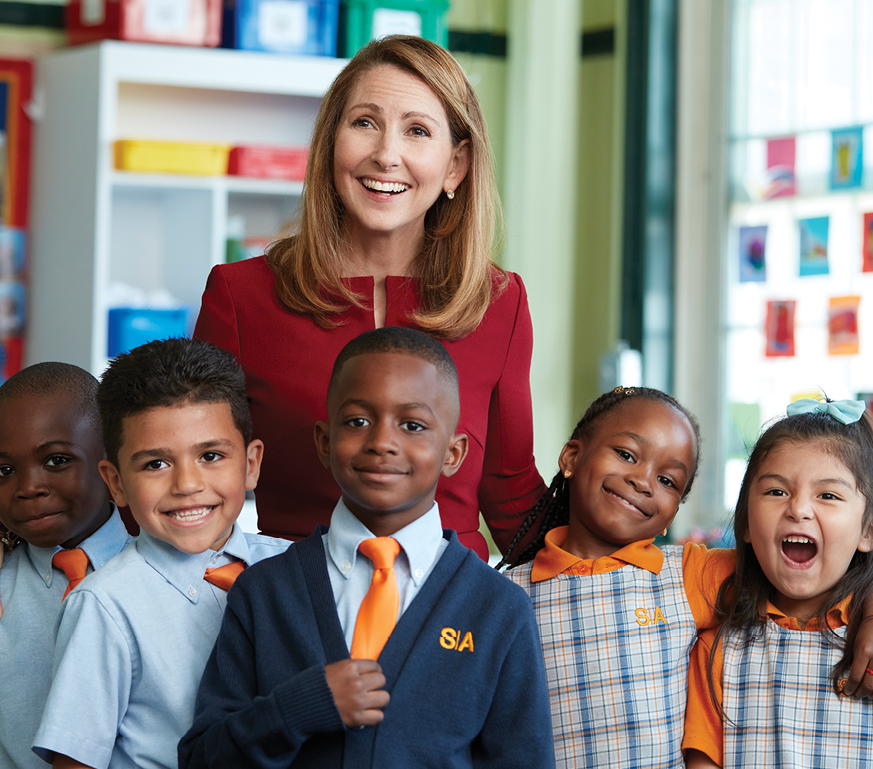- Home
- Media Kit
- Current Issue
- Past Issues
- Ad Specs-Submission
- Ad Print Settings
- Reprints (PDF)
- Photo Specifications (PDF)
- Contact Us


![]()
ONLINE

A Magical Learning Community

Eva Moskowitz with Success Academy students
Editors’ Note
Eva Moskowitz founded Success Academy Charter Schools in 2006. Her experience as a teacher, college professor, elected official, Chair of the New York City Council’s Education Committee and public school parent make her uniquely qualified to effectively lead the organization in establishing high-performing schools and pioneering for educational excellence.
Institution Brief
Founded in 2006, Success Academy Charter Schools (successacademies.org) are free public K-12 schools open to all children in the state through a random lottery. With 46 schools across Brooklyn, the Bronx, Manhattan and Queens, Success Academy enrolls 15,500 students, primarily low-income children of color in disadvantaged neighborhoods. Last year, Success Academy schools received more than 17,000 applications for only 3,000 open seats.
What led you to create Success Academy Charter Schools?
We have far too many kids in this country who are not getting the education they deserve and are entitled to and I was trying to be part of the solution.
How did you anticipate being able to effectively make that change?
I thought that we could have great public schools that were schools of choice that admitted kids by a random lottery. We felt we could create a magical learning community that taught reading and math but also science five days a week as well as the visual arts, dance, sports, chess, debate and coding. This meant that poorer kids could have what might be offered at an elite independent school, but it would be free and done on a public basis.
Did you meet resistance for this idea early on?

Success Academy activities
I got a lot of buy in from parents – last year, 17,000 parents applied at our schools for only 3,000 open seats. Parents are voting with their feet and want great schools. We serve largely poor, disadvantaged students in neighborhoods where, often, there is not a great school.
The resistance comes from the Teachers Union and politicians who are trying to keep things the way they are. We represent change and innovation and the future.
How scalable is this model and what can be done to accommodate more students?
We’re the seventh largest school district in the State of New York and we’re number one in terms of student achievement, even though we are serving quite economically disadvantaged children.
We have 46 schools right now, and we have brought those on within 12 years. We think we’ll get to 100 schools in the next eight to 10 years.
Are there specific areas that you are focused on for growth?
Our growth will be in the five boroughs in the City of New York, but through something we’ve developed called the Education Institute, we are sharing all of our intellectual property for free to educators and social entrepreneurs around the world. We also just opened the Robertson Center, which is a training center for educators and a thought leadership center for everyone interested in reforming public education.
Why hasn’t there been more of an impact on the education system with all of the efforts being made?
We are the number one spender in the world on education and yet, internationally, we are 34th in math and 20th in reading, and we drop every year.
In New York City, we spend $31 billion every single year and 90 percent of the schools, in my view, don’t work on a basic level, meaning they don’t teach kids to read or to count.

Success Academy activities
This is a large problem, but it’s not just because of the labor contract; it’s also the regulatory framework and the ossified bureaucracy. One of the things that bureaucracies are really good at is perpetuating themselves. The bureaucracy is not really serving the needs of children or fostering teaching and learning; it’s about expansion and, politically, it’s hard to change that because there are vested interests. There are a lot of jobs and a lot of money at stake.
How important has it been to continue to invest in offering a full spectrum of educational options?
It’s critical. We don’t call things like art extracurricular because we believe it’s co-curricular – the non-academic subjects are as important as the academic subjects. Every child at Success takes chess and science five days a week, and we have a very robust electives program even in the elementary school. We have 4,000 kids playing in our world-class soccer program; we have robust basketball teams and track teams, as well as competitive chess teams, debate teams and math teams. It’s important not only because we are raising children with broad interests, but it makes school pleasurable for kids when they get to explore their talents and passions.
How critical is parental engagement?
We are big believers in parental investment. We can’t educate kids without parents. That doesn’t mean they run the school, but we need their support to not only ensure their kids are growing academically, but that they are growing socially and emotionally. We want to build a community where parents are at the soccer games and attend the art shows. We want to create communities of kids, parents and teachers.
What has been the key to attracting the quality teachers that Success Academy is known for?
We train our teachers. Recently, charters were given the right to certify their own teachers, so we have the luxury of looking for talented, energetic, self-aware and self-reflective learners who love children and then training them to be our teachers.
It’s hard work to be a teacher – it takes a lot of physical and intellectual stamina, but we’re a magnet for talent. We’re the Google of education. We are getting young, smart and socially conscious people to join Success Academy and become lifelong educators.
Teachers also do a lot with data analytics and they’re managing the instruction in their classroom. We can offer people incredible career trajectories from teacher to principal to superintendent or from teacher to working on the curriculum team to working on the marketing team, etc. Our home office has incredible diversity of content areas and expertise.
How important is it to keep an entrepreneurial spirit and feel within the organization?
The world is changing and we need to keep up. Since education has been stuck in the 19th century, it is not a sector that has been rethought. It’s critical that we remain very entrepreneurial so we can both crack the code and break the educational sound barrier.
Our goal is to graduate all our students from college in four years, and that has never been done before in a beta 12 model at scale.
What made you feel the timing was right to publish your book and what is your main message?
I wrote the book because I have been at Success for 12 years, and there are a lot of misconceptions about charter schools and why it’s so difficult to transform schools and do right by kids. After seven years as an elected official working on this issue and 12 years as an educational entrepreneur, I wanted to share some basic conclusions I have drawn.
My journey is unusual because I’m a liberal democrat and yet I believe strongly in parental and school choice. I tell the story of how I came to believe why that is so important.
Are you able to take moments to appreciate what you have builtss?
I do. I was a principal for the first year of the school and I recently went to a high school play for the kids that I knew in first grade. This is quite special. One of the things I love about this work is talent development. I love investing in the people and helping them fulfill their dreams and aspirations and watching them become highly skilled and have such an impact.
What do you tell people about meeting the challenges in education?
The data could lead to despair and the size of the problem is incredibly daunting, but I’m optimistic that if we put our minds to it, we can solve this problem. We know how to educate kids well and there are many ways to do it. I believe that, if the leaders across this country commit to educational equity and keeping the American Dream alive, we will solve this problem.•